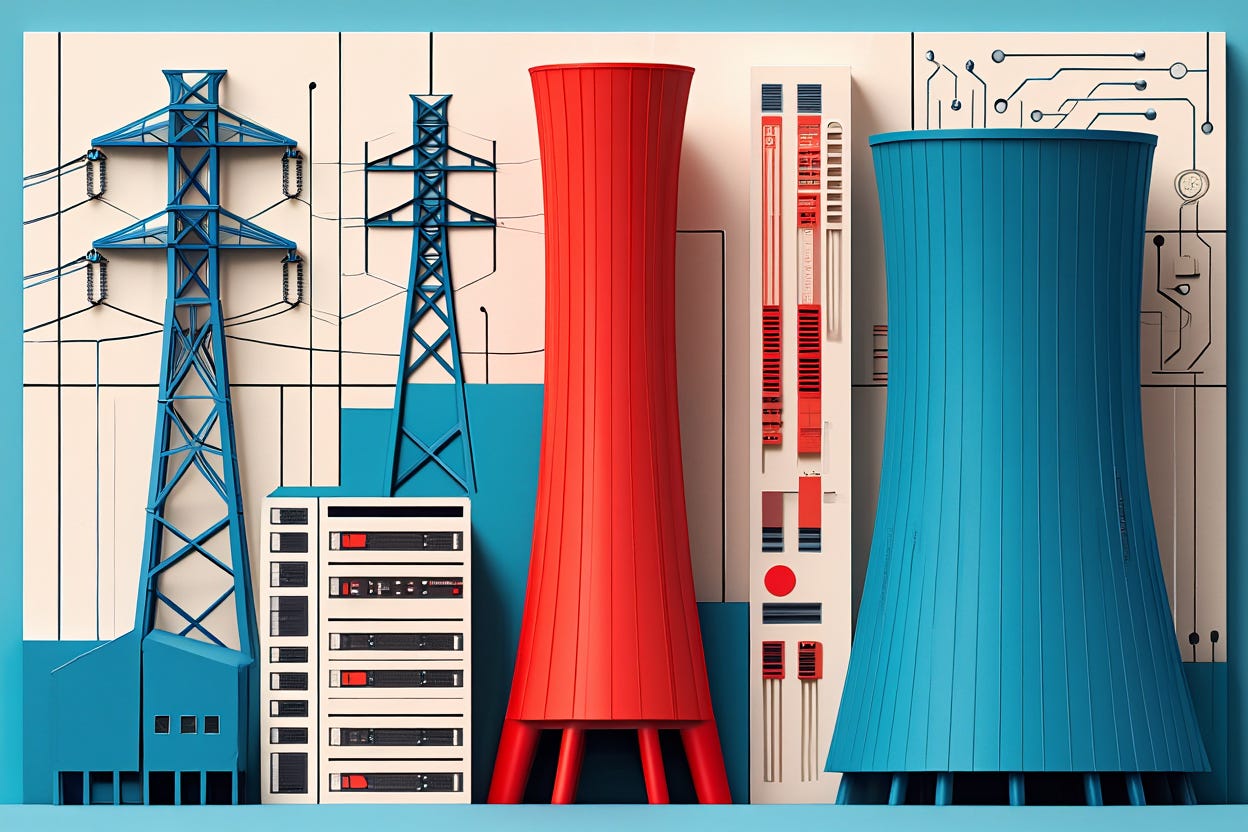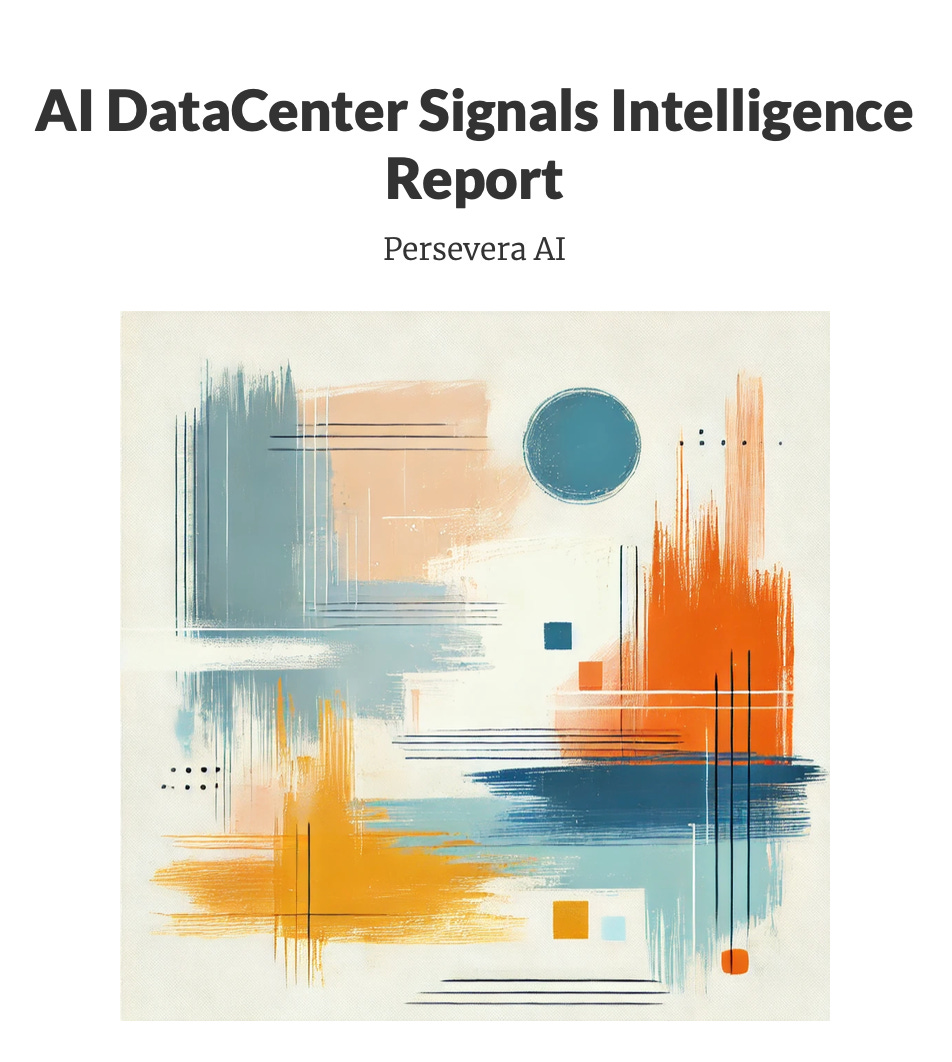10,000MW by 2030: The AI Power Infrastructure Alpha Opportunity Hiding in Plain Sight
How Nuclear Integration and Strategic Land Banking Create Insurmountable Competitive Advantages for Early AI Infrastructure Investors
Part 1 of 3: The Critical Intelligence Series for AI Infrastructure Investors
This is the first in a three-part series examining investment opportunities in AI infrastructure. This intelligence series will reveal critical insights for investors making capital allocation decisions in the rapidly evolving AI infrastructure landscape. Today we focus on power infrastructure constraints and opportunities, while upcoming instalments will cover cooling technology bottlenecks (Part 2) and stealth deployment strategies (Part 3).
While headlines focus on AI model capabilities and token pricing, a massive transformation is happening beneath the surface - one that will determine the true winners and losers in the AI race. This transformation isn't about algorithms or data, but about physical infrastructure - specifically, the power systems that enable AI to function at unprecedented scale.
For investors allocating capital in the AI ecosystem, understanding the hidden dynamics of power infrastructure has become essential. The companies that secure access to gigawatt-scale power resources today will gain insurmountable advantages for the next decade, while those that fail to solve the power equation may find themselves permanently relegated to the second tier of AI providers.
The 10,000MW Reality
The scale of power demand for AI infrastructure is staggering and accelerating faster than publicly acknowledged:
Salt River Project has executed contracts with 40 large data customers requiring over 10,000 MW by 2030, positioning Phoenix as the second largest U.S. datacenter hub behind Virginia
The Buckeye, Arizona development envisions a 1,800 MW campus on 2,069 acres, capable of supporting 40 hyperscale facilities
The Memphis Metro Area development requires 800MW+ for just Phase 1, supporting infrastructure for more than a million NVIDIA H100 GPUs
The Arizona-Sonora Corridor development plans a 1.5GW multi-site cluster spanning the US-Mexico border
These aren't incremental increases - they represent a fundamental shift in scale. A single AI campus now requires power capacity comparable to what would serve a city of millions. This is creating a fierce, largely invisible competition for energy resources that will reshape the competitive landscape.
The companies that secure access to gigawatt-scale power resources today will gain insurmountable advantages for the next decade, while those that fail to solve the power equation may find themselves permanently relegated to the second tier of AI providers.
The Nuclear-AI Integration Alpha
Perhaps the most significant trend emerging from our intelligence is the strategic integration of AI infrastructure with nuclear power:
AWS has acquired a datacenter campus with a direct connection to Talen Energy's nuclear power station in Salem Township, Pennsylvania, with 960MW capacity
The Buckeye, AZ development is strategically positioned adjacent to the Palo Verde nuclear plant
Duke Energy is leveraging their nuclear baseload capacity to position the Carolinas as prime datacenter locations
Microsoft/OpenAI consortium is planning "Stargate-Scale" 5GW+ campuses with nuclear facility integration
This nuclear-AI integration represents a fundamental competitive advantage. The steady, carbon-free baseload that nuclear provides aligns perfectly with the constant power demands of large-scale AI training clusters. Companies securing direct nuclear access gain independence from grid constraints, price volatility, and the intermittency challenges of renewable energy.
For investors, this trend creates clear signals about which companies are positioning themselves for long-term AI leadership. The nuclear integration strategy isn't just about securing power - it's about creating moats that competitors cannot easily cross.
Strategic Land Banking: The Hidden Race
Below the surface of public announcements lies an aggressive pattern of strategic land acquisition, with both hyperscalers and infrastructure developers racing to secure optimal sites for AI infrastructure:
The Buckeye, AZ development represents a massive 2,069-acre site capable of supporting up to 40 hyperscale campuses
Wyoming-Idaho Energy Corridor shows acquisition of 200+ acre parcels along strategic transmission routes with direct access to new 500kV Gateway West line capacity
Northern Latitudes data indicates acquisition of over 500 acres with streamlined permitting for immersion cooling systems
What makes these acquisitions particularly noteworthy is their strategic positioning near power infrastructure. The pattern reveals a deliberate strategy to control not just the immediate building footprint, but entire energy corridors capable of supporting long-term expansion.
Even more interesting is the widespread use of shell companies and stealth acquisition tactics to mask ownership:
In the Wyoming-Idaho Energy Corridor, early-stage discussions between transmission operators and hyperscale developers are being observed in permit commentary filings rather than direct applications
The Memphis Metro Area development facing controversy over its massive power requirements suggests the potential involvement of Tesla/xAI
Stealth land acquisitions near nuclear facilities for the Microsoft/OpenAI "Stargate-Scale" initiative
This clandestine approach allows tech giants to assemble large land portfolios without tipping off competitors or triggering premature price increases from sellers who might realize the strategic value of their properties.
The nuclear-AI integration strategy isn't just about securing power- it's about creating moats that competitors cannot easily cross.
Geographic Power Corridors Emerging Globally
The competition for power resources is reshaping the geography of AI infrastructure, with distinct regional patterns emerging across continents:
North American Power Hubs
Several North American regions are emerging as key AI infrastructure corridors:
Cross-Border Energy Integration
Evidence points to increasing cross-border strategies to optimize energy access while maintaining strategic market positioning:
The Arizona-Sonora Corridor development involves a 1.5GW multi-site cluster with cross-border transmission agreements pending between the US and Mexico
In Asia-Pacific, Acen Corporation's development of 1.2GW+ of floating solar and wind capacity in the Philippines, Australia, and Laos is strategically positioned near Singapore/Malaysia datacenter hubs
These developments suggest hyperscalers are using cross-border relationships to optimize access to power resources while maintaining strategic proximity to existing infrastructure.
Tariff-Driven Geographic Arbitrage
Trump's reciprocal tariffs are significantly reshaping datacenter siting decisions:
NVIDIA re-routing GPU board assembly through Malaysia (0% under USMCA) to avoid the 35% tariff on GPU boards
Equinix shifting immersion tank orders to Mexico to avoid the 45% tariff on dielectric fluids
The Arizona-Sonora Corridor development potentially serving as a hyperscaler hedge against US energy constraints through cross-border integration
The tariff pressures are accelerating existing geographic diversification strategies, with regions offering tariff advantages gaining preference for new development.
Power Generation Technology Diversity
AI datacenter operators are pursuing a diversified power generation strategy:
Nuclear Power Integration
Nuclear power is emerging as a key component of AI infrastructure strategy:
AWS's direct connection to Talen Energy's nuclear plant (960MW) in Salem Township, PA
Duke Energy's positioning of the Carolinas as prime datacenter locations due to nuclear baseload capacity
Buckeye, AZ development's adjacency to the Palo Verde nuclear plant
These nuclear-powered AI facilities represent a significant departure from previous datacenter energy strategies and suggest a new era of nuclear-AI integration.
Renewable Hybridization
Hybrid energy approaches are evident across several developments:
Digital Power Optimization's hybrid renewables + datacenter colocation sites (100-200MW typical capacity) in the Southwest/Western US
Mountain Regions' pairing of hydropower expansion with water rights acquisitions
Coastal Regions pursuing offshore wind-to-hydrogen conversion facilities
This hybridization pattern allows AI infrastructure to leverage renewable resources while addressing intermittency challenges.
Hydrogen Integration for Resilience
Hydrogen is emerging as a strategic technology for AI datacenter resilience:
Douglas County PUD's green hydrogen project in Washington state creating "future DC-H2 synergies"
Intermountain Power Agency's hydrogen storage-integrated combined cycle gas turbine (840MW) creating a "Southwest desert renewable-H2 corridor"
Southern California Edison/LADWP's hydrogen-ready combined cycle gas turbines positioning the LA Basin as a transitional energy hub for AI deployments
The AI race is fundamentally a race for power infrastructure. Companies without secured power access face significant deployment delays and potential stranded assets - regardless of their chip allocations or funding levels.
Undisclosed Competition for Power Resources
The data reveals significant evidence of undisclosed competition for power resources, with hyperscalers engaging in what could be characterized as "power wars" to secure capacity before competitors:
Pre-emptive Capacity Reservations
Multiple data points suggest hyperscalers are making massive pre-emptive power capacity reservations:
Salt River Project's contracts with 40 large data customers requiring over 10,000 MW by 2030
Dominion Energy's contractual commitments to provide 40GW of capacity to datacenters by 2025, nearly doubling their previous capacity allocation
Tier 2 Energy Markets (US) showing "utilities negotiating blockchain-secured capacity reservations for GPU farms"
These capacity reservations appear to be competitive in nature, with hyperscalers racing to secure available power before competitors.
Stealth Power Acquisitions
Evidence points to stealth activities specifically focused on securing power resources without alerting competitors:
Confidential developer pursuing 50-150MW behind-the-meter solar+storage installations with "early land option agreements near existing substations"
Microsoft/OpenAI "Stargate" initiative's land acquisitions near nuclear facilities
"Landscaping contracts near Lee Valley Park suggest hidden edge DC site prep" in East London
These stealth activities suggest hyperscalers are working to secure power resources without alerting competitors to their strategies.
Investment Implications: The Power Alpha Opportunity
For investors, these trends create both significant opportunities and risks:
Alpha Opportunities
Nuclear-Adjacent Real Estate: Properties within transmission distance of existing nuclear facilities are likely to see significant value appreciation as AI providers compete for access to reliable baseload power.
Transmission Infrastructure Developers: Companies with expertise in high-voltage transmission development will see increasing demand as AI facilities require dedicated power corridors.
Behind-the-Meter Solution Providers: Companies offering solar+storage solutions designed specifically for AI workloads will benefit from hyperscalers seeking to bypass grid constraints.
Hydrogen Integration Specialists: As hydrogen emerges as a key resilience technology for AI infrastructure, companies specializing in hydrogen storage and generation will see increased demand.
Cross-Border Infrastructure Developers: Organizations with expertise navigating regulatory environments across borders will be uniquely positioned to capitalize on the emerging USMCA AI corridor.
Risk Factors
Grid Constraint Exposure: Companies developing AI infrastructure without secured power access face significant deployment delays and potential stranded assets.
Regulatory Approval Timelines: Even well-funded projects can face years of delays navigating the complex regulatory environment for power infrastructure.
Tariff Navigation Complexity: The evolving tariff landscape creates complex challenges for supply chain management, with potential for significant cost increases if not properly navigated.
Geographic Concentration Risk: Excessive concentration in any single power corridor creates vulnerability to regional disruptions, regulatory changes, or natural disasters.
Conclusion: The Power-Centric Future of AI
The evidence is clear: the AI race is fundamentally a race for power infrastructure. Companies that secure access to gigawatt-scale power resources today will gain decisive advantages that may prove insurmountable for years to come.
For investors, this creates both urgency and opportunity. Understanding the hidden dynamics of power acquisition, the strategic significance of nuclear integration, and the emerging geographic corridors is essential for making informed allocation decisions in the AI infrastructure space.
In our next instalment, we'll examine the cooling technology bottlenecks creating both constraints and opportunities in the AI infrastructure landscape. We'll reveal how thermal management has become a critical strategic battleground, with evidence of stealth stockpiling, critical component shortages, and emerging underground secondary markets.
This analysis is based on Persevera AI's AI DataCenter Signals Intelligence research service, which provides investment firms with detailed analysis of emerging trends, hidden opportunities, and strategic risks in AI infrastructure.
Our intelligence reveals critical opportunities and risks hidden from standard market analysis, giving investors the asymmetric information advantage needed to identify emerging trends, make superior investment decisions, and generate alpha in the rapidly evolving AI infrastructure landscape.
To request the full intelligence package, including our complete analysis of power infrastructure trends, cooling technology bottlenecks, and stealth deployment strategies, visit https://persevera.ai/ai-datacenter-signals-intelligence or contact our team directly.



